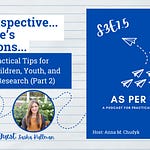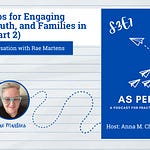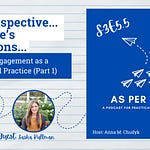Meet our guest listener
Kathy Smith: Kathy Smith is a cancer survivor and a cancer care partner actively engaged as a co-author in many healthcare research projects - including Anna M. Chudyk’s work on better understanding patient partners’ perspectives on engagement and exploring future directions for Canadian patient-oriented research. She is a patient research/awards reviewer for many organizations including the Canadian Cancer Society.
Episode Transcript:
Anna:
Hi everyone! Welcome to Season 3's first episode of onePERspective. As a reminder, this is a tri-weekly segment in which patient partner Kathy Smith shares a synopsis and key reflections from the previous week's episode of asPERusual -- a podcast for practical patient engagement. My name is Anna Chudyk and I am asPERusual’s host. Before I turn things over to Kathy to provide a recap of Season 3 Episode 1, I want to do a huge shout out to her. Kathy, you faced huge tech related barriers that would have made most other people peace out on making this episode a reality. But you kept trying all week and persevering and here we finally are. Something you kept saying was, I don't want to let you down. But the thing is, I don't think you could ever let me down if you tried. Our long-standing bond grew out of and transcends or working relationship, and that's what patient engagement is all about. So thank you so much, Kathy, for loving this labor of love of a podcast as much as I do. And now let me turn it over to you for your onePERspective.
Kathy Smith:
Thank you Anna and hello everyone. First off, I would like to gratefully acknowledge the ancestral keepers of the beautiful and bountiful land upon which my city of Thunder Bay was built about a quarter of a century ago. We are at the epicenter of Canada, at the head of the greatest, deepest and cleanest of the Great Lakes, Lake Superior, the mighty Gitche Gumee. This area is the traditional territory and homeland of the Anishinaabe People, which includes the Ojibwa/Chippewa of Fort William First Nation, signatories to the Robinson Superior Treaty of 1850. My father's family migrated from Sweden to Turtle Island (Canada) in the late 1800s. They all settled in Minnesota, but only my grandfather preferred to live and work in Canada as a lumberjack. My mother's family also first migrated to America way back in the early 1700s. A family joke is that they told the Mayflower where to land. They moved first up to New Brunswick, as United Empire Loyalists, with some settling here to work in the forest building and serving the railway. Both families chose to live and thrive here in pristine northwestern Ontario, and they gratefully spoke often of the huge debt we owed to its original land keepers.
Whether as a child in the family car on a Sunday drive to nowhere, or as a mom camping everywhere with my own four children, or now just meandering with my hubby along the majestic woodland trails, I am in awe of the breathtaking, balance, and restoring beauty of our natural surroundings. I respect the ancestral stewards for their profound spiritual connection to Mother Earth and all the living things that guided them to practice reverence, humility and reciprocity with her gifts of pure air, clean water, mineral rich soil, and abundant flora and fauna. I am very grateful also for the significant contributions made by the Metis Peoples, both past and present. Miigwech!
Thank you to our Building Capacity with SPOR IMAGINE guests Aida Fernandes (executive director), along with Dr. Deborah Marshall and Sandra Zelinsky, co-leads of the Patient Engagement Subcommittee. You all wear different hats with your lived and work experience backgrounds, but you are all laser focused on partnering to better manage inflammatory bowel disease (IBD) and irritable bowel syndrome (IBS). Your IMAGINE network is shedding some much needed light on these puzzling and troubling chronic disorders. I have seen a close friend’s partner struggle and stumble with Crohn's disease, one of the inflammatory bowel diseases. Needing to be hyper vigilant with what he eats and ever mindful of maintaining a work life balance is difficult. And he pretty much had to learn by trial and error. He recently passed away from pancreatic cancer, but I know he would be extremely delighted to see that the Mind And Gut Interactions Cohort (MAGIC) Study focuses on more proactive and preventative strategies than on reactive treatment regimes.
WOWZA! Almost 8000 subjects were recruited into the pan-Canadian MAGIC study by the IMAGINE network. Participants were retained in the study in high numbers even though they had to submit quarterly blood, stool, and urine samples. How did IMAGINE accomplish this incredible feat? With the aid of a very strong, very engaged, very well trained and supported patient partner group. 40 patient peer-to-peer mentors conducted face-to-face and/or online virtual contacts with the participants in the study to encourage and support them. The patients engaged as partners in the research had flexibility in how and when they could contribute to the study. The IMAGINE network met patient partners where they were at and what they were comfortable with contributing. Anna compared this to Roger Stoddard's choosing patient engagement tasks from a menu analogy, because appetites are all different when it comes to the amount of engagement one can or will want to do. Patient engagement was kept strong by relying on this flexibility, plus good support, plus capacity building and first and foremost, once again, respectful relationship building.
The unique but equally valuable voices and perspectives of the 4 Ls that Linxi Mytkolli told us about in asPERusual’s Diabetes Action Canada podcast delivers the lived, the lovers, the learners (so the academic leads) and the laborers (all the clinicians) blended together to make this one strong, patient centric study. Patients and providers also had access to tools necessary to support their preferred level and type of engagement. Anna has posted a really good list of these resources recommended by today's guests. In particular, they highlighted the free online patient and community engagement research (PaCER) program, a one year certificated course from the University of Calgary. It teaches patient research partners how to create, conduct, and even lead a research project. In fact, that's the requirement for the certificate.
Another way patient engagement was supported reached beyond taking part in the research study process. IMAGINE empowered patients to share their lived experience stories. Having just completed this task myself, I sure wish I had access to that training with the help from patient mentors like Sandra. Storytelling is harder than it looks.
All in all, this is a very strong study with a very strong network of networks and a very strong method of patient engagement. I wish the team much success. Miigwech.
PERsonally Speaking
My three big takeaways will sound pretty familiar.
The secret sauce to any successful patient engagement in research platform is to overcommunicate at the start. Make friends. Take all the time at the start to develop the bidirectional relationships needed to build a strong team of friends. Teamwork makes the dream work. Know the end game goal. List the tasks needed to get there, and then collaborate as a team to “match the hat to the task.” Impressed IMAGINE seems to have no power differential barrier at play. Regular feedback and ongoing evaluation can help maintain a productive and respectful partnership.
If we focus research funding on lived experience patient priorities like MAGIC’s mind-gut biome connection study, it not only enriches the research process, but also ensures that the outcomes are more relevant and beneficial to those who need them the most. Patients are the alpha and the omega of health care.
Thank you to SPOR Strategy for Patient-Oriented Research for all your resource allocation for studies that bridge the gap between science and experience. Working together, maybe we will get more proactive strategies to better self-manage many chronic diseases. I'm very optimistic MAGIC will make some magic happen for patients with IBD and IBS.
Anna:
Thanks so much Kathy for sharing your onePERspective. I think this is my favorite one yet. Something that really also stood out for me about IMAGINE was the pivotal role that patient research partners play in shaping research within the network and throughout the research cycle. The MAGIC study is such an impressive undertaking, having enrolled almost 8000 patients in a Pan-Canadian longitudinal venture. To see meaningful and active engagement interwoven into it is beyond heartening and definitely something we can all stand to learn from. If you haven’t checked the original episode out, it is Season 3 Episode 1 of asPERusual and can be accessed through visiting our website asperusual.substack.com or wherever it is that you download your other podcast episodes from. If you do visit the website, be sure to check out the interactive transcript from this, and other episodes, as well as to subscribe to the podcast’s newsletter! As always, you can reach me by emailing anna.asperusual@gmail.com or by adding me to LinkedIn by searching Anna M. Chudyk – CHUDYK.
In two weeks I’ll be releasing Season 3 Episode 2 of asPERusual, where I sit down with Melanie Talson and Cathy Woods from the Canadians Seeking Solutions and Innovations to Overcome Chronic Kidney Disease (Can-SOLVE CKD) network. Be sure to tune in if you want to learn about their systemic approach to patient engagement, including ways in which the six R’s ( Respect, Responsibility, Reciprocity, Relevance, Relationships, and being Real) permeate all aspects of the network’s work, and the role of the network’s Indigenous Peoples’ Engagement and Research Council (IPERC) in shaping engagement and care for Indigenous Peoples and communities across Canada.
Until next time, thanks again for tuning in and let’s keep working together to make patient engagement the standard, or asPERusual.












